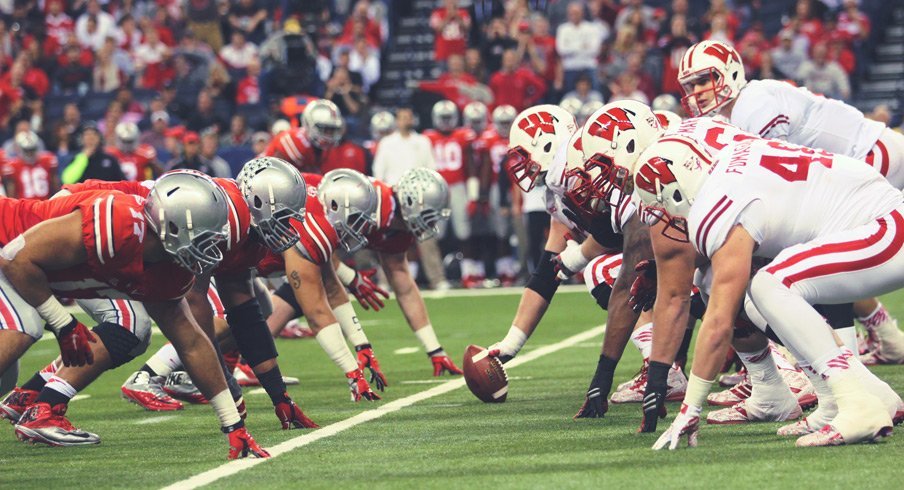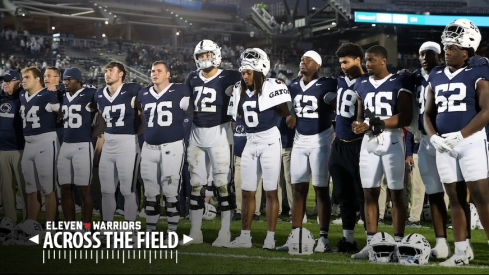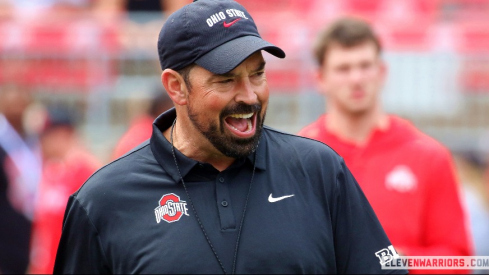Setting the edge. Playing contain. The force player.
We hear these terms used by coaches, players, announcers, media members, and fans, but what do they really mean? How do they fit into Ohio State’s defensive philosophy? What do they look like on the football field?
Before examining the concept in more detail and looking at some film, it’s important to understand former co-defensive coordinator Chris Ash’s base defensive alignment and gap responsibilities (also known as 'run fits'). We've has previously written about the Silver Bullets' base 4-3, over front in which run defenders are responsible for a single gap or running lane, known as a one-gap defense (Keep in mind that football terms are not universal; different coaches often use different verbiage when referring to the same concept).

Run defense is often described as a well-choreographed dance. All eleven defenders must work together to take the ball to the ground, and each must have absolute trust in their teammates to be in the right spot at the right time.
In a single-gap defense, each in-the-box player is responsible for a one, and only one gap. Playing outside of this gap is THE cardinal sin in a single-gap defense, as the integrity of the run defense is contingent on every player being in his assigned area. When a coach or announcer says a player is ‘free-lancing’ after a big play, they are referring to a player not being in his assigned space.
 Before taking a more detailed look at setting the edge, it is important to understand how the concept fits into head coach Urban Meyer’s philosophy of stopping the run.
Before taking a more detailed look at setting the edge, it is important to understand how the concept fits into head coach Urban Meyer’s philosophy of stopping the run.
Ohio State plays a spill philosophy in which the defense’s goal is to force the ball carrier to run laterally, or sideline to sideline. When executed properly the spill philosophy will leave the runner with no crease/hole to run upfield, allowing the defense to tackle the ball carrier for a minimal gain.

Because a football field is 53.3 yards wide, it is impossible to chase the ball carrier the entire width of the field. To narrow the distance the defense must cover, the critical force player acts as the fulcrum to force the ball back inside to the spill players, who will make the tackle. The ubiquitous terms setting the edge, playing contain, or forcing the ball inside all refer to this concept.
The defense will always assign two force players (one on each side of the field), with the players being formation-dependent. A defensive end, linebacker, cornerback, and/or safety can be responsible for setting the edge based on the defense’s specific gap-assignments and the offense’s formation. When identifying the force players a good rule of thumb is to look for defenders aligned just outside the core of the offense’s formation.

Coaches teach a variety of techniques to force the ball back inside, but most spill philosophies are based on three fundamental principles:
- Read the run key
- Attack the gap/squeeze
- Do not let the ball carrier get outside
Quick, accurate run/pass key reads are the hallmark of a well-coached defense. Interior defenders generally read the center/guard, while perimeter players read the EMLOS (End Man Line Of Scrimmage), generally a tackle or tight end. The importance of a quick key read cannot be overemphasized, as this allows the defender to play with maximum speed and violence.

Once the defender has read “run” from their key, they move to the second phase of the technique, attacking the gap.
Force players are coached to aggressively attack the blocker inside their assigned gap. The defender should attack the outside of the blocker using his inside foot and shoulder

Notice how the defender attacks the blocker's outside shoulder using his inside shoulder and near foot. This prevents the defender from being pushed inside, which would allow the ball carrier to take the ball outside the force player.
Attacking the blocker with proper leverage is just as important as using the inside foot and arm. The force player must not attack inside to the B-gap or penetrate too deeply into the backfield, as this will allow the ball carrier to get outside the edge.
By attacking at the proper angle, the edge-setter forces the ball carrier to make the decision to cut the ball upfield quicker while narrowing the space in which the ball carrier can run. This technique is known as ‘squeezing the gap’. Effective run defenders not only hold, but also constrict the edge of the offensive formation. Ball carriers want time and space in which to work; squeezing the gap eliminates both. The force player must fight to avoid being moved out of his assigned gap as this creates time and space for the player with the ball.


Watch how the right defensive end attacks the left tackle, holding his area at the point of attack and eliminating time and space for the running back.
The final phase of the technique is not letting the ball carrier get outside. The force defender should fight to keep his outside shoulder free, or ‘clean' at all costs. A clean outside shoulder allows the defender to attack the ball carrier should he try to run around him. By attacking with the near shoulder and foot, the defender puts his body in a position through which he can use his outside arm to prevent the ball from going outside.
Coaches teach a variety of techniques to force the ball back inside, with hand usage and a strong base being key components.

Watch weak-side linebacker Josh Perry (#37) force the ball carrier inside and disengage from his blocker to make the tackle. The tackle is a bonus, as he has already set a hard edge, forcing the running back towards the spill players.
What does setting the edge look like when all three components are put together? Watch strong-side linebacker Darron Lee (#43) execute his assignment to perfection in the image below.

Notice Lee quickly read his key (the down block from #52), avoid the block from the pulling offensive lineman, squeeze the ball back inside, and make the tackle. This is an NFL-caliber play.
Now that we know what setting the edge should look like, what are some of the common mistakes defenders make, often leading to big gains?
The first (and most common) mistake defenders make is allowing themselves to be pinned inside, letting the ball carrier run outside for big gains.
Penn State running back Saquon Barkley gashed the Buckeye run defense for 194 yards on 26 carries. A majority of these yards came when the talented freshmen was able to bounce the ball outside due to Ohio State defenders being pinned inside.

Focus on the right defensive end. By allowing the left tackle to reach his outside shoulder, he loses leverage and is pinned inside, creating a large running lane that Barkley exploits for a large first down gain.
Another common mistakes force players will make is penetrating too far upfield, creating large running lanes for the ball carrier to run through.

Both the left defensive end and defensive tackle shoot too far upfield, creating a large lane for Barkley.
With a New Year's Day matchup against a Notre Dame team averaging 214 rush yards-per-game looming, the Silver Bullets must continue to emphasize the importance of setting the edge in the run game. Irish running backs C.J. Prosise (6.6 yards per carry) and Josh Adams (7.4 yards per carry) are both explosive runners with touchdowns runs of over 90 yards this season. If the Buckeye defense hopes to eliminate these chunk gains, setting the edge every play will go a long way to bottling up these dangerous runners.


